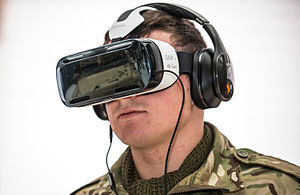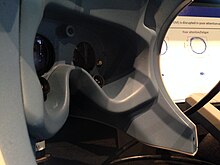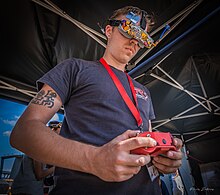


Ahead-mounted display (HMD) is a display device, worn on the head or as part of a helmet (see helmet-mounted display for aviation applications), that has a small display optic in front of one (monocular HMD) or each eye (binocular HMD). HMDs have many uses including gaming, aviation, engineering, and medicine.[1]
Virtual reality headsets are a type of HMD that track 3D position and rotation to provide a virtual environment to the user. 3DOF VR headsets typically use an IMU for tracking. 6DOF VR headsets typically use sensor fusion from multiple data sources including at least one IMU.
Anoptical head-mounted display (OHMD) is a wearable display that can reflect projected images and allows a user to see through it.[2]

A typical HMD has one or two small displays, with lenses and semi-transparent mirrors embedded in eyeglasses (also termed data glasses), a visor, or a helmet. The display units are miniaturized and may include cathode ray tubes (CRT), liquid-crystal displays (LCDs), liquid crystal on silicon (LCos), or organic light-emitting diodes (OLED). Some vendors employ multiple micro-displays to increase total resolution and field of view.
HMDs differ in whether they can display only computer-generated imagery (CGI), or only live imagery from the physical world, or combination. Most HMDs can display only a computer-generated image, sometimes referred to as virtual image. Some HMDs can allow a CGI to be superimposed on real-world view. This is sometimes referred to as augmented reality (AR) or mixed reality (MR). Combining real-world view with CGI can be done by projecting the CGI through a partially reflective mirror and viewing the real world directly. This method is often called optical see-through. Combining real-world view with CGI can also be done electronically by accepting video from a camera and mixing it electronically with CGI.
An optical head-mounted display uses an optical mixer which is made of partly silvered mirrors. It can reflect artificial images, and let real images cross the lens, and let a user look through it. Various methods have existed for see-through HMD's, most of which can be summarized into two main families based on curved mirrors or waveguides. Curved mirrors have been used by Laster Technologies, and by Vuzix in their Star 1200 product. Various waveguide methods have existed for years. These include diffraction optics, holographic optics, polarized optics, and reflective optics.
Major HMD applications include military, government (fire, police, etc.), and civilian-commercial (medicine, video gaming, sports, etc.).

In 1962, Hughes Aircraft Company revealed the Electrocular, a compact CRT(7" long), head-mounted monocular display that reflected a TV signal in to transparent eyepiece.[3][4][5][6] Ruggedized HMDs are increasingly being integrated into the cockpits of modern helicopters and fighter aircraft. These are usually fully integrated with the pilot's flying helmet and may include protective visors, night vision devices, and displays of other symbology.
Military, police, and firefighters use HMDs to display tactical information such as maps or thermal imaging data while viewing a real scene. Recent applications have included the use of HMD for paratroopers.[7] In 2005, the Liteye HMD was introduced for ground combat troops as a rugged, waterproof lightweight display that clips into a standard U.S. PVS-14 military helmet mount. The self-contained color monocular organic light-emitting diode (OLED) display replaces the NVG tube and connects to a mobile computing device. The LE has see-through ability and can be used as a standard HMD or for augmented reality applications. The design is optimized to provide high definition data under all lighting conditions, in covered or see-through modes of operation. The LE has a low power consumption, operating on four AA batteries for 35 hours or receiving power via standard Universal Serial Bus (USB) connection.[8]
The Defense Advanced Research Projects Agency (DARPA) continues to fund research in augmented reality HMDs as part of the Persistent Close Air Support (PCAS) Program. Vuzix is currently working on a system for PCAS that will use holographic waveguides to produce see-through augmented reality glasses that are only a few millimeters thick.[9]
Engineers and scientists use HMDs to provide stereoscopic views of computer-aided design (CAD) schematics.[10] Virtual reality, when applied to engineering and design, is a key factor in integration of the human in the design. By enabling engineers to interact with their designs in full life-size scale, products can be validated for issues that may not have been visible until physical prototyping. The use of HMDs for VR is seen as supplemental to the conventional use of CAVE for VR simulation. HMDs are predominantly used for single-person interaction with the design, while CAVEs allow for more collaborative virtual reality sessions.
Head Mounted Display systems are also used in the maintenance of complex systems, as they can give a technician a simulated x-ray vision by combining computer graphics such as system diagrams and imagery with the technician's natural vision (augmented or modified reality).
There are also applications in surgery, wherein a combination of radiographic data (X-ray computed tomography (CAT) scans, and magnetic resonance imaging (MRI) imaging) is combined with the surgeon's natural view of the operation, and anesthesia, where the patient vital signs are within the anesthesiologist's field of view at all times.[11]
Research universities often use HMDs to conduct studies related to vision, balance, cognition and neuroscience. As of 2010, the use of predictive visual tracking measurement to identify mild traumatic brain injury was being studied. In visual tracking tests, a HMD unit with eye tracking ability shows an object moving in a regular pattern. People without brain injury are able to track the moving object with smooth pursuit eye movements and correct trajectory.[12]
Low-cost HMD devices are available for use with 3D games and entertainment applications. One of the first commercially available HMDs was the Forte VFX1 which was announced at Consumer Electronics Show (CES) in 1994.[13] The VFX-1 had stereoscopic displays, 3-axis head-tracking, and stereo headphones. Another pioneer in this field was Sony, which released the Glasstron in 1997. It had as an optional accessory a positional sensor which permitted the user to view the surroundings, with the perspective moving as the head moved, providing a deep sense of immersion. One novel application of this technology was in the game MechWarrior 2, which permitted users of the Sony Glasstron or Virtual I/O's iGlasses to adopt a new visual perspective from inside the cockpit of the craft, using their own eyes as visual and seeing the battlefield through their craft's own cockpit.
Many brands of video glasses can be connected to modern video and DSLR cameras, making them applicable as a new age monitor. As a result of the glasses ability to block out ambient light, filmmakers and photographers are able to see clearer presentations of their live images.[14]
The Oculus Rift is a virtual reality (VR) head-mounted display created by Palmer Luckey that the company Oculus VR developed for virtual reality simulations and video games.[15] The HTC Vive is a virtual reality head-mounted display. The headset is produced by a collaboration between Valve and HTC, with its defining feature being precision room-scale tracking, and high-precision motion controllers. The PlayStation VR is a virtual reality headset for gaming consoles, dedicated for the PlayStation 4.[16] Windows Mixed Reality is a platform developed by Microsoft which includes a wide range of headsets produced by HP, Samsung, and others and is capable of playing most HTC Vive games. It uses only inside-out tracking for its controllers.
Some head-mounted displays are designed to present traditional video and film content in a virtual cinema. These devices typically feature a relatively narrow field of view (FOV) of 50–60°, making them less immersive than virtual-reality headsets, but they offer correspondingly higher resolution in terms of pixels per degree. Released in 2011, the Sony HMZ-T1 featured 1280x720 resolution per eye. In approximately 2015, standalone Android 5 (Lollipop) based "private cinema" products were released using various brands such as VRWorld, Magicsee, based on software from Nibiru.
Products released as of 2020 featuring 1920×1080 resolution per eye included the Goovis G2[17] and Royole Moon.[18] Also available was the Avegant Glyph,[19] which incorporated 720P retinal projection per eye, and the Cinera Prime,[20] which featured 2560×1440 resolution per eye as well as a 66° FOV. The rather large Cinera Prime used either a standard support arm or an optional head mount. Expected to be available in late-2021 was the Cinera Edge,[21] featuring the same FOV and 2560×1440 resolution per eye as the earlier Cinera Prime model, but with a much more compact form factor. Other products available in 2021 were the Cinemizer OLED,[22] with 870×500 resolution per eye, the VISIONHMD Bigeyes H1,[23] with 1280x720 resolution per eye, and the Dream Glass 4K,[24] with 1920x1080 resolution per eye. All of the products mentioned here incorporated audio headphones or earphones except for the Goovis G2, the Cinera Prime, the VISIONHMD Bigeyes H1, and the Dream Glass 4K, which instead offered an audio headphones jack.

First-person view (FPV) drone flying uses head-mounted displays which are commonly called "FPV goggles".[25][26] Analog FPV goggles (such as the ones produced by Fat Shark) are commonly used for drone racing as they offer the lowest video latency. But digital FPV goggles (such as produced by DJI) are becoming increasingly popular due to their higher resolution video.
Since 2010s, FPV drone flying is widely used in aerial cinematography and aerial photography.[27]
A HMD system has been developed for Formula One drivers by Kopin Corp. and the BMW Group. The HMD displays critical race data while allowing the driver to continue focusing on the track as pit crews control the data and messages sent to their drivers through two-way radio.[28] Recon Instruments released on 3 November 2011 two head-mounted displays for ski goggles, MOD and MOD Live, the latter based on an Android operating system.[29]
A key application for HMDs is training and simulation, allowing to virtually place a trainee in a situation that is either too expensive or too dangerous to replicate in real-life. Training with HMDs covers a wide range of applications from driving, welding and spray painting, flight and vehicle simulators, dismounted soldier training, medical procedure training, and more. However, a number of unwanted symptoms have been caused by prolonged use of certain types of head-mounted displays, and these issues must be resolved before optimal training and simulation is feasible.[30]


Depth perception inside an HMD requires different images for the left and right eyes. There are multiple ways to provide these separate images:
The advantage of dual video inputs is that it provides the maximum resolution for each image and the maximum frame rate for each eye. The disadvantage of dual video inputs is that it requires separate video outputs and cables from the device generating the content.
Time-based multiplexing preserves the full resolution per each image, but reduces the frame rate by half. For example, if the signal is presented at 60 Hz, each eye is receiving just 30 Hz updates. This may become an issue with accurately presenting fast-moving images.
Side-by-side and top-bottom multiplexing provide full-rate updates to each eye, but reduce the resolution presented to each eye. Many 3D broadcasts, such as ESPN, chose to provide side-by-side 3D which saves the need to allocate extra transmission bandwidth and is more suitable to fast-paced sports action relative to time-based multiplexing methods.
Not all HMDs provide depth perception. Some lower-end modules are essentially bi-ocular devices where both eyes are presented with the same image. 3D video players sometimes allow maximum compatibility with HMDs by providing the user with a choice of the 3D format to be used.
|
Extended reality (XR)
| |||||||||||
|---|---|---|---|---|---|---|---|---|---|---|---|
| |||||||||||
| Concepts |
| ||||||||||
| Technologies |
| ||||||||||
| Peripherals |
| ||||||||||
| Devices |
| ||||||||||
| Software |
| ||||||||||
|
| |
|---|---|
| Perception |
|
| Display technologies |
|
| Other technologies |
|
| Product types |
|
| Notable products |
|
| Miscellany |
|
|
| |||||||||
|---|---|---|---|---|---|---|---|---|---|
|
|
| ||||||||
| Helmets |
| ||||||||
| Other protective |
| ||||||||
| Hairwear and other items |
| ||||||||
| Eyewear |
| ||||||||
|
| |||||||||
|---|---|---|---|---|---|---|---|---|---|
| Fields |
| ||||||||
| |||||||||